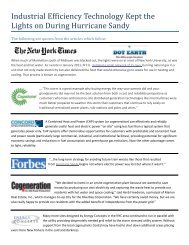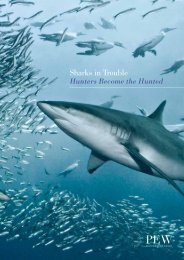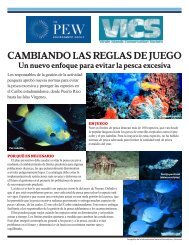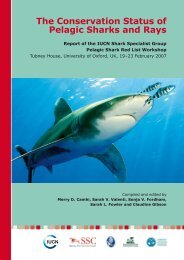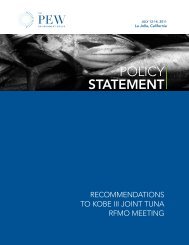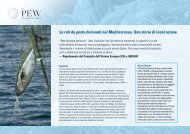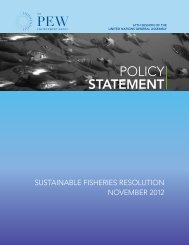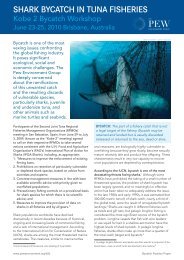The Law That's Saving American Fisheries - Ocean Conservancy
The Law That's Saving American Fisheries - Ocean Conservancy
The Law That's Saving American Fisheries - Ocean Conservancy
You also want an ePaper? Increase the reach of your titles
YUMPU automatically turns print PDFs into web optimized ePapers that Google loves.
I. Introduction and summary<br />
Cod—shown drying in Gloucester, MA, in the 1800s—were abundant in New England in the 19th century,<br />
but by the 20th century, they were severely overexploited.<br />
NOAA<br />
For more than 200 years, the catch of important fish such as cod and bass, sardines and salmon, and<br />
oysters and clams helped America build ports, communities, and industries. <strong>The</strong>se historic fisheries<br />
contributed not only to the nation’s food supply but also to its economy, culture, and trade. Individual<br />
states regulated local fishing fleets, but their authority generally ended three miles from shore, far enough<br />
to oversee coastal fishing. <strong>The</strong> federal government had more pressing concerns than policing the millions of<br />
square miles where fishermen, frigate birds, and whales plied the waters.<br />
Prosperity after World War II ushered in a golden age for<br />
America’s commercial and recreational fishermen. <strong>The</strong> former<br />
had a hungry nation to feed and faced few competitors as the<br />
world recovered from the conflict. Recreational fishermen<br />
exerted their influence beyond freshwater with the dawning<br />
of the sportfishing industry, trailerable boats, and advanced<br />
fishing gear.<br />
But America was not the only place where the engines of<br />
technology thrust fishing into the 20th century and far<br />
beyond nearshore waters. Bigger, faster, more powerful foreign<br />
factory ships arrived by the hundreds and began emptying<br />
the ocean’s larders off U.S. shores. Fishing industry leaders<br />
from regions such as New England, the Pacific Northwest,<br />
and Alaska turned to their representatives in Congress for<br />
measures with a longer reach than states’ three-mile jurisdiction.<br />
<strong>The</strong>y had seen proof that modern fishing methods could<br />
deplete oceans that once seemed inexhaustible. It was time<br />
to bring the rule of law to the open sea. 1<br />
In 1976, with the passage of what is now known as the<br />
Magnuson-Stevens Fishery Conservation and Management<br />
Act—led by Senators Warren Magnuson (D-WA) and Ted<br />
Stevens (R-AK)—the United States took charge of all that<br />
swims, scuttles, and tastes good in the world’s largest exclusive<br />
economic zone: 3.4 million square miles of sea.<br />
A generation of determined, farsighted commercial and recreational<br />
fishermen, marine scientists, and legislators shaped<br />
that law. <strong>The</strong>y brought to it lessons learned the hard way,<br />
based on principles that are simple and sound. <strong>The</strong>y believed<br />
that the nation’s rich fishing grounds could feed generations<br />
of <strong>American</strong>s far into the future, but only if catches were<br />
well-controlled. 2 Many of them knew that it would pay off to<br />
leave enough fish in the water to regenerate healthy stocks in<br />
the future.<br />
But politics is the art of the possible, and the law in its<br />
original form was well-designed but not watertight. U.S.<br />
4 It’s a Keeper



